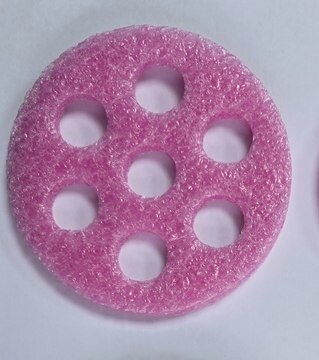Unfortunately, there is no direct correlation between linear pore size measurements and nominal pore ratings based on retention of globular proteins (MWCO). However, several publications are available describing the separation of QDs by size based on the membrane MWCO. Please see the link below to review an example of one such publication:
https://pmc.ncbi.nlm.nih.gov/articles/PMC8271461/
D9652
Dialysis tubing cellulose membrane
avg. flat width 33 mm (1.3 in.)
Sinonimo/i:
Cellulose Dialysis Tubing, Cellulose Membrane, Dialysis Membrane
About This Item
Prodotti consigliati
Diametro medio
21 mm , when full
Larg.media se piatto
33 mm (1.3 in.)
Capacità
~110 mL/ft
Cerchi prodotti simili? Visita Guida al confronto tra prodotti
Descrizione generale
Confezionamento
Qualità
Nota sulla preparazione
Codice della classe di stoccaggio
13 - Non Combustible Solids
Classe di pericolosità dell'acqua (WGK)
WGK 3
Punto d’infiammabilità (°F)
Not applicable
Punto d’infiammabilità (°C)
Not applicable
Scegli una delle versioni più recenti:
Certificati d'analisi (COA)
It looks like we've run into a problem, but you can still download Certificates of Analysis from our Documenti section.
Se ti serve aiuto, non esitare a contattarci Servizio Clienti
Possiedi già questo prodotto?
I documenti relativi ai prodotti acquistati recentemente sono disponibili nell’Archivio dei documenti.
I clienti hanno visto anche
Contenuto correlato
Dialysis Tubing
-
What is the molecular weight cut off for the Dialysis tubing cellulose membrane avg. flat width 33 mm (1.3 in.) with product number D9652? Is this suitable for purification of Quantum Dots which have size range from 2-10nm.
1 answer-
Helpful?
-
-
Which organic solvents can be used with these membranes?
1 answer-
Regenerated cellulose membranes are typically compatible with acids and alcohols. Organic solvent compatibility varies from compound to compound. However, the solvent concentration, temperature, and exposure time are factors to be considered. Please see the table below to review the general membrane compatibility with various solvents.
Helpful?
-
-
how do I prepare the tubings before usage?
1 answer-
Instructions have been provided in the 'Preparation Note' in the 'DESCRIPTION' section.
-Wash the tubing in running water for 3-4 hours to remove glycerol included as a humectant.
-Treat the tubing with a 0.3% (w/v) solution of sodium sulfide at 80°C for 1 minute to remove sulfur compounds.
-Wash with hot water (60°C) for 2 minutes, followed by acidification with a 0.2% (v/v) solution of sulfuric acid, then rinse with hot water to remove the acid.
This tubing will retain most proteins of molecular weight 12,000 or greater.Helpful?
-
Active Filters
Il team dei nostri ricercatori vanta grande esperienza in tutte le aree della ricerca quali Life Science, scienza dei materiali, sintesi chimica, cromatografia, discipline analitiche, ecc..
Contatta l'Assistenza Tecnica.






